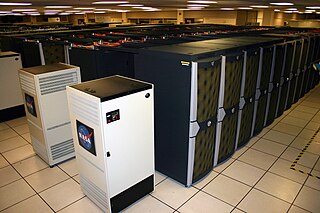BIGSIM is a computer simulation and performance modeling system for parallel computing, typically used for very large computer clusters. [1] [2] BIGSIM was developed at the University of Illinois. [3]

Parallel computing is a type of computation in which many calculations or the execution of processes are carried out simultaneously. Large problems can often be divided into smaller ones, which can then be solved at the same time. There are several different forms of parallel computing: bit-level, instruction-level, data, and task parallelism. Parallelism has long been employed in high-performance computing, but it's gaining broader interest due to the physical constraints preventing frequency scaling. As power consumption by computers has become a concern in recent years, parallel computing has become the dominant paradigm in computer architecture, mainly in the form of multi-core processors.

A computer cluster is a set of loosely or tightly connected computers that work together so that, in many respects, they can be viewed as a single system. Unlike grid computers, computer clusters have each node set to perform the same task, controlled and scheduled by software.
When a large scale, often supercomputer level, parallel system is being developed, it is essential to be able to experiment with multiple configurations and simulate performance. BIGSIM provides these facilities by allowing the simulation of performance on various node topologies, message passing and scheduling strategies. [1]

A supercomputer is a computer with a high level of performance compared to a general-purpose computer. The performance of a supercomputer is commonly measured in floating-point operations per second (FLOPS) instead of million instructions per second (MIPS). Since 2017, there are supercomputers which can perform up to nearly a hundred quadrillion FLOPS. Since November 2017, all of the world's fastest 500 supercomputers run Linux-based operating systems. Additional research is being conducted in China, the United States, the European Union, Taiwan and Japan to build even faster, more powerful and more technologically superior exascale supercomputers.

Network topology is the arrangement of the elements of a communication network. Network topology can be used to define or describe the arrangement of various types of telecommunication networks, including command and control radio networks, industrial fieldbusses, and computer networks.
BIGSIM includes an emulator and a trace-based simulator. [2] The emulator executes applications on a small number of nodes and stores the results, so the simulator can use them and simulate activities on a much larger number of nodes. [2]
The simulator is a discrete event simulator (based on the POSE system) which is trace driven and uses POSE's Charm++ base. [1] BIGSIM can simulate both the processing components and the message passing system to provide an overall view of system performance characteristics. [1]
Charm++ is a parallel object-oriented programming language based on C++ and developed in the Parallel Programming Laboratory at the University of Illinois at Urbana–Champaign. Charm++ is designed with the goal of enhancing programmer productivity by providing a high-level abstraction of a parallel program while at the same time delivering good performance on a wide variety of underlying hardware platforms. Programs written in Charm++ are decomposed into a number of cooperating message-driven objects called chares. When a programmer invokes a method on an object, the Charm++ runtime system sends a message to the invoked object, which may reside on the local processor or on a remote processor in a parallel computation. This message triggers the execution of code within the chare to handle the message asynchronously.
The emulator stores information of sequential execution blocks (SEBs) for multiple processors in log files, with each SEB recording the messages sent, their sources and destinations, dependencies, timings, etc. The simulator reads the log files and simulates them, and may star additional messages which are then also stored as SEBs. [1] [2]
The simulator can thus provide a view of the performance of very large applications, based on the execution traces provided by the emulator on a much smaller number of nodes, before the entire machine is available, or configured. [2]



